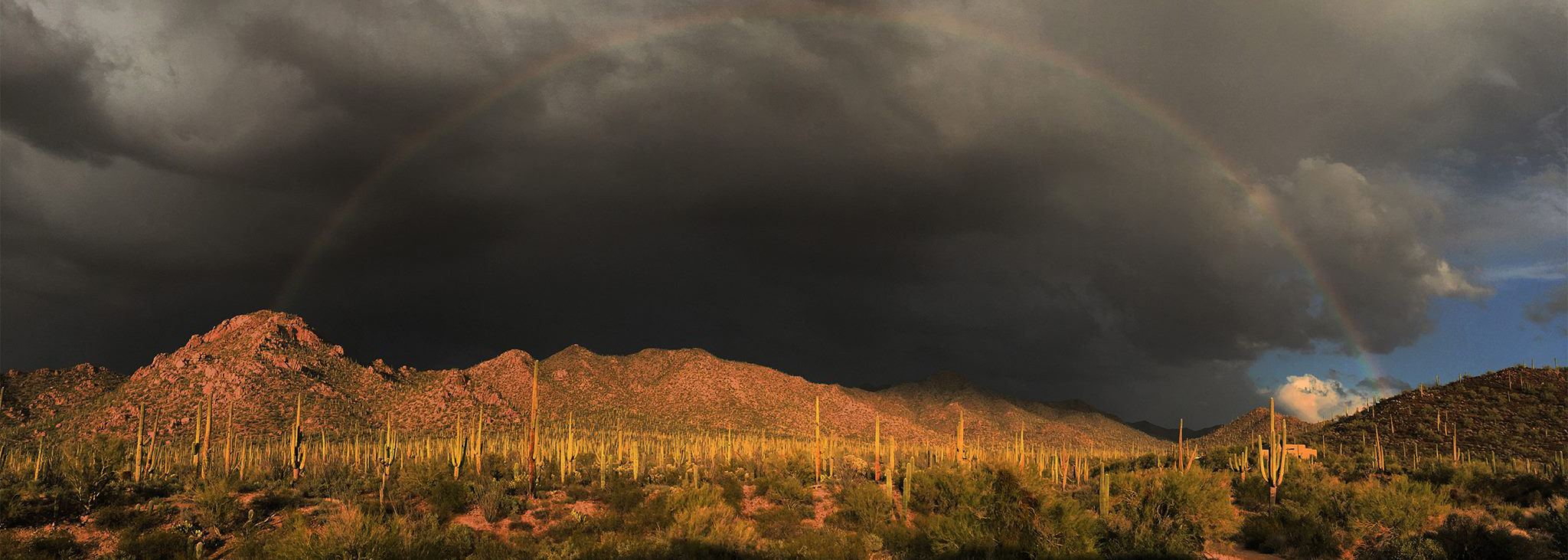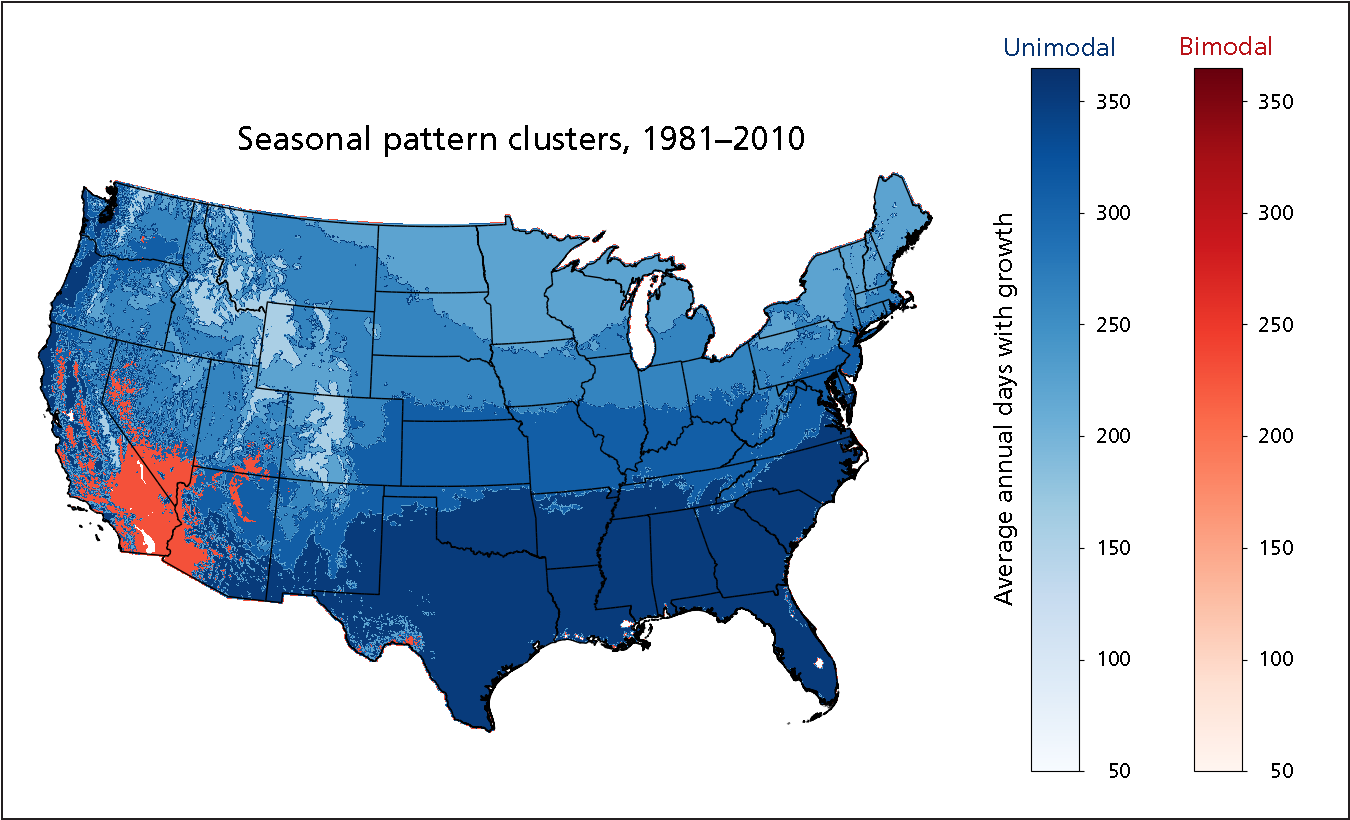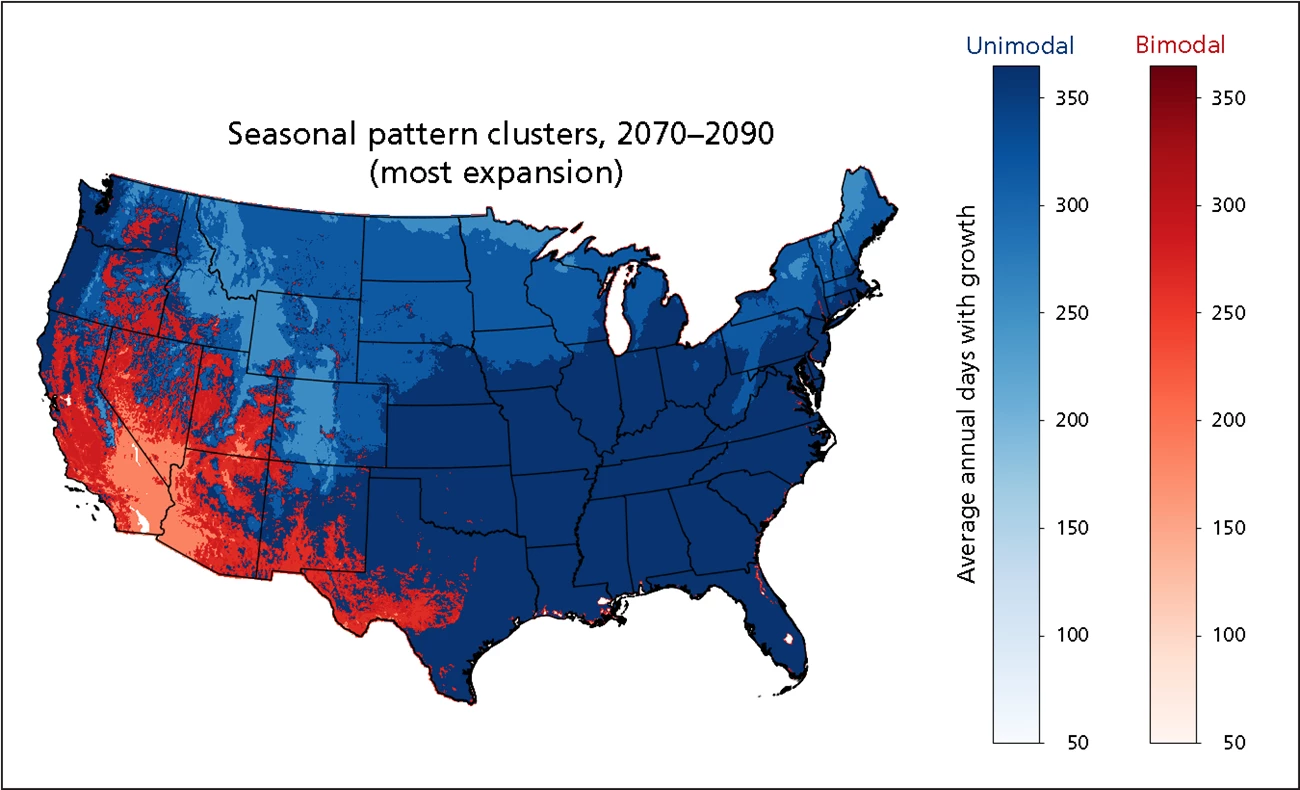Last updated: July 20, 2023
Article
A Changing Bimodal Climate Zone Means Changing Vegetation in Western National Parks

Storm clouds over Saguaro National Park.
Plant Growth and the Bimodal Climate Zone
An expanded bimodal climate zone will have important impacts on plant communities. In western national parks, some communities are more likely to change than others.
The charismatic vegetation that gives southwestern parks their quintessentially “western” feel is threatened by climate change in ways we might not expect. Saguaro cacti, grasslands, shrublands, and pinyon-juniper all grow where the climate meets their needs. Some of these species, such as the saguaro, rely on slow growth to persist in bone-dry summer conditions. Others have deep roots and/or can drop their leaves to conserve water. Due to their finely tuned traits and distributions, we can be certain that when the climate changes enough, the vegetation communities growing in any given place will also change.
Plant growth happens when there is water in the soil, and temperatures warm enough to allow transpiration (water use by plants) and photosynthesis (plants’ conversion of light into energy). Systems in different places are limited by different factors. In temperature-limited systems, water is plentiful. The growing season is limited by the consecutive months warm enough for transpiration. In water-limited systems, plant growth occurs when dry soil has been recharged by winter rains, snowmelt, and/or episodic pulses of precipitation.
Many water-limited systems, such as the semi-arid southwestern US, have a bimodal growing season (Figure 1). Here, two growth peaks occur: one in spring and another in late summer. The first peak occurs when spring temperatures become warm enough for plants to use soil moisture from the previous winter and spring. After the spring soil moisture is used up, plant activity slows or stops until late-summer rains recharge the soil. This allows for the second, smaller growth peak.

Figure 1. Areas within the continental United States that historically (1981–2010) contained bimodal seasonal patterns (red) and unimodal patterns (blues). Shades of red and blue (see color ramps at right) indicate the average number of days with plant growth each year (0–365 possible). White patches represent areas with missing data.
Warming temperatures and/or precipitation changes could lead the US bimodal zone to expand into new areas. These changing climate patterns will likely result in significant changes to plant communities, with cascading ecological consequences. To help park managers plan for possible future scenarios, National Park Service ecologists from the Northern Colorado Plateau Network and Climate Change Response Program worked with partner Walking Shadow Ecology to map continental US regions projected to experience bimodal growing seasons in the future.
Future Expansion of the Bimodal Zone
Using climate projections to drive a water-balance model, we focused on two climate scenarios, or Representative Concentration Pathways (RCPs). RCP 4.5 represents an anthropogenic top-of-atmosphere climate forcing of 4.5 watts/m2 at the year 2100. It would require a rapid stabilization in greenhouse gas emissions. RCP 8.5 represents a continued increase in greenhouse gas emissions at a rate similar to the present. Within the RCPs, 13 General Circulation Models (GCMs) were selected to bracket the range of projected future changes in temperature and precipitation.
Under every future scenario (i.e., RCP/GCM combination), the bimodal growing zone increased. This was true for both mid-century (2040–2069) and late-century (2070–2099) projections. Under the smallest-expansion scenario within RCP 8.5 projections, the bimodal zone grew primarily around its historical area, moving only slightly into Texas and more northern states (Figure 2). Under the future with the largest expansion, the bimodal area extended from central Texas to central California to Washington (Figure 3).


Left image
Figure 2. Areas within the continental United States under the late-century future with the least areal expansion of bimodal seasonal patterns (red) and unimodal patterns (blues) under RCP 8.5.
Right image
Figure 3. Areas within the continental United States under the late-century future with the most areal expansion of bimodal seasonal patterns (red) and unimodal patterns (blues) under RCP 8.5.
Increases in growing-season bimodality are driven by increasing aridity in summer, which is caused by two interacting mechanisms. One is a reduction of summer precipitation. The other is increased evapotranspiration (evaporation plus water use by plants), which depletes soil moisture at a faster rate. Our results reflect the presence of both mechanisms. For example, a hot, reduced-precipitation projection for Big Bend National Park portends marked declines in summer precipitation, resulting in very low growth in late summer. In contrast, a hot, similar-precipitation projection for Capitol Reef National Park resulted in more days above freezing in November–March, leading to increased winter growth. This is likely to exhaust soil-moisture reserves more quickly than in the past, resulting in drought that hampers summer growth.
Potential Effects on Composition and Distribution of Plant Communities
An increase in the bimodal zone will have important impacts on plant communities. Some communities are more likely to persist than others.
To survive, plants need to exploit key resources when they are most available, and reduce or abstain when they are scarce. One framework for thinking about the traits and trade-offs of plant adaptation is the RSK scheme. Grime (1977, 1979) described plant species as ruderal (R), stress-tolerant (S), or competitive (K), according to their life strategies (see table).
Plant traits and survival strategies that make them more or less well adapted to bimodal climates.
| Life history | Life strategies | Well-suited to bimodal environments? | Examples |
|---|---|---|---|
| Ruderal (R) |
|
Yes | Annual forbs and grasses (e.g., invasive cheatgrass) |
| Stress-tolerant (S) |
|
Yes | Cacti, deep-rooted shrubs (e.g., blackbrush) |
| Competitive (K) |
|
No | Larger species, including many trees (e.g., pinyon pine) |
In regions with newly bimodal climate patterns, a mid-season growth stoppage would be a severe disturbance for K-strategy plants. K-strategy plants are less able to seek refuge in seeds (R-strategy) or use stress-tolerance mechanisms (S-strategy) to survive dry spells. They are also susceptible to hydraulic disruption (e.g., air within their xylem that is difficult to purge). This kind of disturbance can cause sudden, acute damage, pushing K-strategy plants past biological tipping points and into widespread mortality.
 Patch of dying junipers with the Abajo Mountains in the background, Cedar Mesa, Utah.
Patch of dying junipers with the Abajo Mountains in the background, Cedar Mesa, Utah.This is already happening. For example, Koehn and others (2022) found that when ponderosa pine (Pinus ponderosa) seedlings experienced summertime hydraulic disruption, they exhibited dieback after only 20–30 days—and more than 90% mortality after 45 days. In southern Utah, Kannenberg and others (2021) documented widespread mortality caused by hydraulic disruption in Utah juniper during midsummer 2018. In the 1950s, a severe drought caused widespread tree mortality in the southwestern US, but did not affect other plant types as severely. And in 2021, Bradford and others (2021) found that trees were particularly susceptible to summer drought. They suggested that managers consider thinning trees to reduce competition for water during drier growing seasons.
Eventually, expanded bimodal seasonality may cause a shift toward R-strategy grasses at the expense of perennial grasses and forbs. It may also cause an increase in stress-tolerant shrubs (S-strategy plants), such as creosote (Larrea tridentata) and mesquite (Prosopis spp.), or small sclerophylls, such as broom snakeweed (Gutierrezia sarothrae). Unfortunately, many R-strategy species are weedy and invasive, so an increasing area of bimodality could result in more “disturbed” or “stressful” habitats that may transition to plant communities with fewer native species. Vegetation composition in newly bimodal areas will also depend on additional factors, such as atmospheric CO2 levels; disturbances, such as fire; and land-use patterns.
What Park Managers Can Do
The results from this study clearly show that the area of bimodal seasonality in the southwestern US will expand, regardless of projected precipitation increases or decreases. This is because with warmer temperatures, increased evapotranspiration will outstrip any gains in soil moisture made by potential increases in precipitation. This gives park managers a warning that plant communities adapted to bimodal seasonality are likely to spread beyond their historical distribution. This mappable pattern may impact many important K-strategy plant species, including trees.
These findings support proactive management. For instance, managers observing a warm-season pause in plant growth in areas where it had not occurred in the past can expect an increased risk of invasive-plant colonization. This sudden, new growth depression might manifest suddenly. And it may portend a transformative event resulting in widespread tree mortality, increased abundance of annual grasses, and encroachment of drought-tolerant shrubs. By identifying this potential early indicator of change, managers may implement proactive climate adaptation to resist, accept, or direct future changes.
This article was summarized from Tercek, M., J. Gross, and D. Thoma. 2023. Robust projections and consequences of an expanding bimodal growing season in the western United States. Ecosphere 14(5), May.
Works Cited
Bradford, B., K. Shriver, M. Robles, L. McCauley, T. Woolley, C. Andrews, M. Crimmins, and D. Bell. 2021. Tree mortality response to drought-density interactions suggests opportunities to enhance drought resistance. Journal of Applied Ecology 59:549–559.
Grime, J.P. 1977. Evidence for the existence of three primary strategies in plants and its relevance to ecological and evolutionary theory. American Naturalist 111:1169–1994.
Grime, J.P. 1979. Primary strategies in plants. Transactions of the Botanical Society of Edinburgh 43:151–160.
Kannenberg, S.A., A.W. Driscoll, D. Malesky, and W. Anderegg. 2021. Rapid and surprising dieback of Utah juniper in the southwestern USA due to acute drought stress. Forest Ecology and Management 480:118639.
Koehn, C., M. Petrie, and R.M. Hubbard. 2022. Not only severe events: Moderate dry periods impact the hydraulic functioning and survival of planted ponderosa pine seedlings. Forests 13:370. https://doi.org/10.3390/f13030370.
Tags
- arches national park
- aztec ruins national monument
- bandelier national monument
- bent's old fort national historic site
- big bend national park
- black canyon of the gunnison national park
- bryce canyon national park
- canyon de chelly national monument
- canyonlands national park
- capitol reef national park
- capulin volcano national monument
- carlsbad caverns national park
- casa grande ruins national monument
- cedar breaks national monument
- chaco culture national historical park
- channel islands national park
- chiricahua national monument
- colorado national monument
- coronado national memorial
- curecanti national recreation area
- death valley national park
- dinosaur national monument
- el malpais national monument
- el morro national monument
- florissant fossil beds national monument
- fort bowie national historic site
- fort davis national historic site
- fort larned national historic site
- fossil butte national monument
- gila cliff dwellings national monument
- golden spike national historical park
- grand canyon national park
- great sand dunes national park & preserve
- guadalupe mountains national park
- hovenweep national monument
- hubbell trading post national historic site
- joshua tree national park
- lake mead national recreation area
- lake meredith national recreation area
- lyndon b johnson national historical park
- mesa verde national park
- mojave national preserve
- montezuma castle national monument
- natural bridges national monument
- organ pipe cactus national monument
- pecos national historical park
- petrified forest national park
- petroglyph national monument
- pipe spring national monument
- rainbow bridge national monument
- rio grande wild & scenic river
- rocky mountain national park
- saguaro national park
- salinas pueblo missions national monument
- sand creek massacre national historic site
- sunset crater volcano national monument
- tonto national monument
- tumacácori national historical park
- tuzigoot national monument
- valles caldera national preserve
- walnut canyon national monument
- washita battlefield national historic site
- white sands national park
- wupatki national monument
- yucca house national monument
- zion national park
- plants
- plant communities
- climate
- climate change
- climate science
- american southwest
- swscience
- climate change effects
- climate change science
- science
- ecosystem monitoring
- landscape scale
- monitoring
- research
- research studies
- research study
- science and resource management
- science and research
- science and resources
- water in the west
- sodn
- romn
- chdn
- medn
- mojn
- ncpn
- scpn
- sopn
- sonoran desert network
- rocky mountain network
- chihuahuan desert network
- mediterranean coast network
- mojave desert network
- northern colorado plateau network
- southern colorado plateau network
- southern plains network
- inventory and monitoring division
- waterbalancecc
